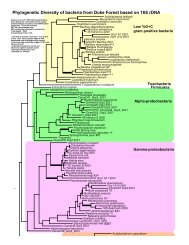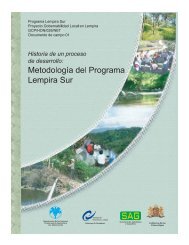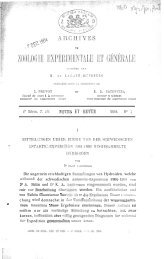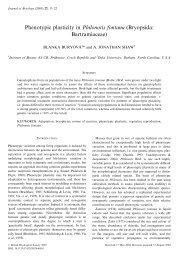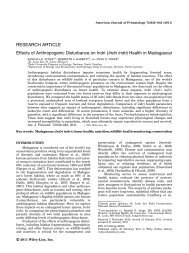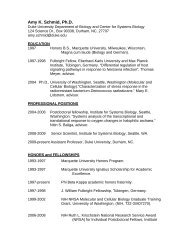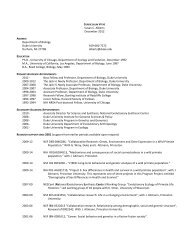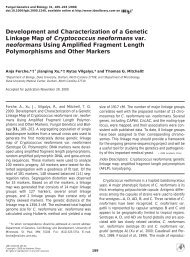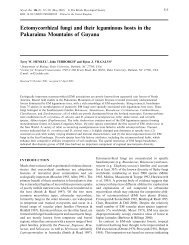Rapid evolution of a polyphenic threshold - Duke Biology - Duke ...
Rapid evolution of a polyphenic threshold - Duke Biology - Duke ...
Rapid evolution of a polyphenic threshold - Duke Biology - Duke ...
Create successful ePaper yourself
Turn your PDF publications into a flip-book with our unique Google optimized e-Paper software.
Moczek and Nijhout <strong>Rapid</strong> <strong>evolution</strong> <strong>of</strong> a <strong>polyphenic</strong> <strong>threshold</strong> 263<br />
other Mediterranean populations, including France, Italy,<br />
Iran, Tunisia, and Morocco. In each comparison, differences<br />
between males collected in North Carolina and the Mediterranean<br />
were significant (P � 0.01 for each comparison; Table<br />
1A). With one exception (Italy, see below), differences<br />
between males collected in North Carolina and in other Mediterranean<br />
samples were attributable entirely (Morocco, Tunisia,<br />
Iran) or largely (France) to differences in the body size<br />
<strong>threshold</strong> (parameter c, P � 0.001 in each case). As before,<br />
North Carolinian males switched to the horned phenotype at<br />
much smaller body sizes and expressed the horned morph<br />
over a much wider range <strong>of</strong> body sizes than their Mediterranean<br />
counterparts (Fig. 2, A and C). French O. taurus also<br />
exhibited a marginally significantly higher slope coefficient<br />
than males collected in North Carolina (T 22 � 2.11; P �<br />
0.046). Interestingly, although log-likelihood contrasts between<br />
males collected in North Carolina and Italy suggested<br />
significant allometric differences between these two populations,<br />
none <strong>of</strong> the four regression parameters was able to account<br />
for these differences. A potential explanation for this<br />
observation may lie in the unusually wide spread <strong>of</strong> data<br />
points within the Italian sample (see Fig. 2C) and a relatively<br />
modest sample size (n � 33).<br />
Pair-wise comparison <strong>of</strong> all<br />
Mediterranean populations<br />
Eighteen pair-wise log-likelihood contrasts <strong>of</strong> all Mediterranean<br />
populations, excluding those between Spain, Greece,<br />
and Turkey presented above, yielded additional significant<br />
differences in seven cases. Three <strong>of</strong> these (two <strong>of</strong> which involved<br />
Italy, see above) could not be accounted for by any <strong>of</strong><br />
the regression parameters. In the three remaining cases, differences<br />
were due to significant differences in the slope<br />
coefficient (parameter b) between samples (Table 1A). No<br />
pair-wise comparison indicated significant differences in parameter<br />
c, suggesting that over most <strong>of</strong> their native geographic<br />
range, male O. taurus employ a similar <strong>threshold</strong><br />
body size to switch from hornless to horned morphologies<br />
(Fig. 2, B and C).<br />
Intra- versus interspecific differences<br />
When compared with each other, Western Australian and<br />
North Carolinian populations differed most dramatically in<br />
the <strong>threshold</strong> body size (T 1191 � 28.92; P � 0.0001), causing<br />
both populations to express opposite phenotypes over a wide<br />
range <strong>of</strong> body sizes (Table 1A, Fig. 2A). In addition, Western<br />
Australian males also expressed a slightly but significantly<br />
higher slope coefficient than their North Carolinian<br />
counterparts (T 1191 � 2.03; P � 0.05).<br />
Onthophagus taurus shares much <strong>of</strong> its native range with<br />
O. illyricus (Balthasar 1963). Onthophagus illyricus also expresses<br />
two alternative male horn morphologies very similar<br />
to those <strong>of</strong> O. taurus (Balthasar 1963; Baraud 1992; Lohse<br />
and Lucht 1992). In fact, the two species are very difficult to<br />
distinguish on the basis <strong>of</strong> external morphological characters<br />
alone and were originally considered varieties <strong>of</strong> the same<br />
species (Balthasar 1963). Male genital morphology, however,<br />
allows for a clear and unambiguous separation <strong>of</strong> both<br />
species and provides a reliable species-diagnostic character<br />
(Lohse and Lucht 1992; Krell, personal communication).<br />
Onthophagus taurus and O. illyricus are now considered sister<br />
species (Baraud 1992; Lohse and Lucht 1992). Exotic O.<br />
taurus populations do not contain O. illyricus (Krell, personal<br />
communication).<br />
Mediterranean O. taurus and sympatric male O. illyricus<br />
differed highly significantly in the average horn length–body<br />
size allometry (L 4 � 159.73). Differences between the two<br />
species were attributable largely to highly significant differences<br />
in the infection point c (T 72 � 17.21; P � 0.0001), suggesting<br />
that apart from genital characters, both species can<br />
also be distinguished by the body size <strong>threshold</strong> between alternate<br />
morphs (Fig. 3). In addition, O. illyricus exhibited a<br />
marginally significantly higher slope coefficient (T 29 � 2.23;<br />
P � 0.0336) than Mediterranean O. taurus. Differences in<br />
<strong>threshold</strong> body sizes and slope coefficients between Mediterranean<br />
O. taurus and O. illyricus were similar in kind and<br />
magnitude to the differences between North Carolinian and<br />
Western Australian populations <strong>of</strong> O. taurus and between<br />
exotic and native O. taurus populations (Table 1B). Combined,<br />
these data suggest that the current morphological divergences<br />
<strong>of</strong> exotic O. taurus populations in North Carolina<br />
and Western Australia may be similar to patterns <strong>of</strong> morphological<br />
differentiation associated with the early stages in the<br />
formation <strong>of</strong> new species in the genus Onthophagus.<br />
Discussion<br />
Polyphenisms are a common extreme <strong>of</strong> phenotypically<br />
plastic trait expression and rely on <strong>threshold</strong> responses to<br />
produce discrete alternative phenotypes (Nijhout 1994; R<strong>of</strong>f<br />
1996; Stearns 1989). Threshold responses are widespread<br />
and essential components <strong>of</strong> many physiological and developmental<br />
processes yet have only relatively recently regained<br />
attention from <strong>evolution</strong>ary biologists (Schmalhausen<br />
1949; Tauber and Tauber 1970; Hazel and West<br />
1982; West-Eberhard 1989, 1992; Kingsolver 1995; Emlen<br />
1996, 2000; R<strong>of</strong>f 1996; Zera and Denno 1997; Hazel et al.<br />
1998; Schlichting and Pigliucci 1998; Lively et al. 1999;<br />
Nijhout 1999; Tomkins 1999). Here we show that exotic and<br />
native populations <strong>of</strong> the <strong>polyphenic</strong> beetle O. taurus differ<br />
most dramatically in the <strong>threshold</strong> body size that separates<br />
alternative male phenotypes. The kind and magnitude <strong>of</strong><br />
<strong>threshold</strong> divergences between native and exotic populations<br />
do not reflect variation in the native range <strong>of</strong> O. taurus but<br />
instead resemble differences normally observed between




